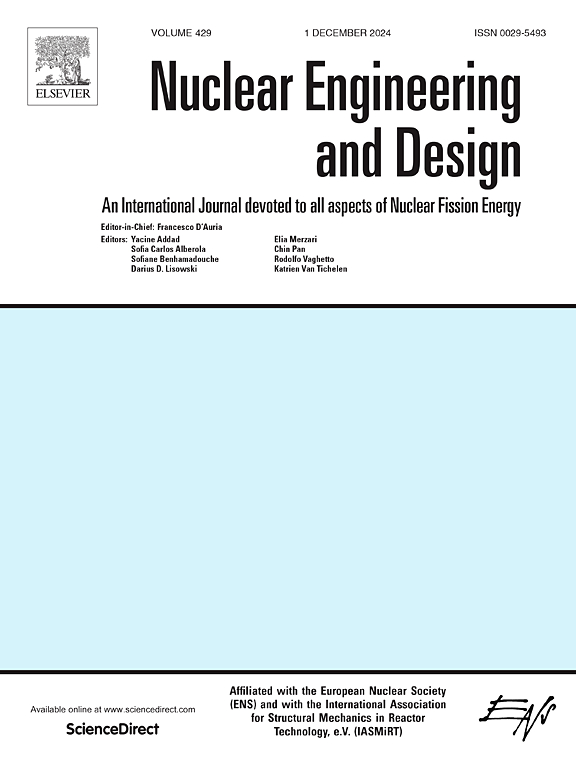Effects of recrystallization on fission gas behavior in U3Si2 fuel at LWR temperature: A combination of phase-field method and rate theory
IF 2.1
3区 工程技术
Q1 NUCLEAR SCIENCE & TECHNOLOGY
引用次数: 0
Abstract
The not well-known fission gas behavior of U3Si2 under light water reactor (LWR) conditions is a key limitation for its application as accident tolerant fuel (ATF) in commercial LWRs. In this paper, we developed a rate theory calculation model based on the kinetic rate theory framework originally developed in the GRASS-SST code, modified by the phase-field method, to investigate the influence of grain size on fission gas behavior in U3Si2 fuel under LWR conditions. The phase=field model examines microstructural development, specifically, evolution in grain size, in U3Si2 fuel. This model is then incorporated into the rate theory framework to analyze fission gas release and the retained fission gas bubble areal fraction during irradiation. The integration of these mesoscale models enhances our understanding of the impact of grain size evolution on fission gas behavior. The simulations of fission gas release show good agreement with post-irradiation examination (PIE) data, providing validation to the model and insights into the varying retained fission gas behavior observed in different regions of irradiated fuel pellet.

重结晶对低水堆温度下U3Si2燃料裂变气体行为的影响:相场法和速率理论的结合
U3Si2在轻水堆(LWR)条件下的裂变气体行为尚不为人所知,这是限制其作为商用轻水堆容错燃料(ATF)应用的关键因素。本文基于GRASS-SST代码中最初发展的动力学速率理论框架,通过相场法进行修正,建立了速率理论计算模型,研究了低水堆条件下晶粒尺寸对U3Si2燃料裂变气体行为的影响。相=场模型考察了U3Si2燃料中微观结构的发展,特别是晶粒尺寸的演变。然后将该模型纳入速率理论框架,分析辐照过程中裂变气体释放量和裂变气体气泡面积分数。这些中尺度模型的整合增强了我们对颗粒尺寸演化对裂变气体行为影响的理解。裂变气体释放的模拟结果与辐照后检验(PIE)数据吻合良好,为模型提供了验证,并深入了解了在辐照燃料球团不同区域观察到的不同保留裂变气体行为。
本文章由计算机程序翻译,如有差异,请以英文原文为准。
求助全文
约1分钟内获得全文
求助全文
来源期刊

Nuclear Engineering and Design
工程技术-核科学技术
CiteScore
3.40
自引率
11.80%
发文量
377
审稿时长
5 months
期刊介绍:
Nuclear Engineering and Design covers the wide range of disciplines involved in the engineering, design, safety and construction of nuclear fission reactors. The Editors welcome papers both on applied and innovative aspects and developments in nuclear science and technology.
Fundamentals of Reactor Design include:
• Thermal-Hydraulics and Core Physics
• Safety Analysis, Risk Assessment (PSA)
• Structural and Mechanical Engineering
• Materials Science
• Fuel Behavior and Design
• Structural Plant Design
• Engineering of Reactor Components
• Experiments
Aspects beyond fundamentals of Reactor Design covered:
• Accident Mitigation Measures
• Reactor Control Systems
• Licensing Issues
• Safeguard Engineering
• Economy of Plants
• Reprocessing / Waste Disposal
• Applications of Nuclear Energy
• Maintenance
• Decommissioning
Papers on new reactor ideas and developments (Generation IV reactors) such as inherently safe modular HTRs, High Performance LWRs/HWRs and LMFBs/GFR will be considered; Actinide Burners, Accelerator Driven Systems, Energy Amplifiers and other special designs of power and research reactors and their applications are also encouraged.
 求助内容:
求助内容: 应助结果提醒方式:
应助结果提醒方式:


